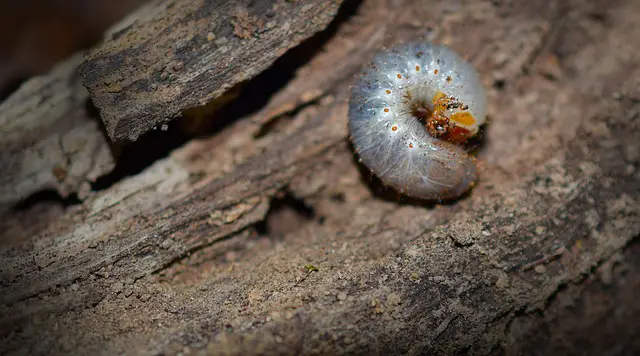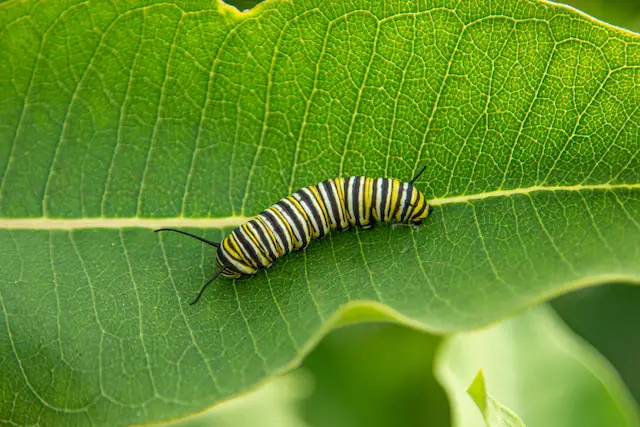Grubs are the larval stage of beetles and have a soft, C-shaped body with no legs or distinct segmentation. Caterpillars, on the other hand, are the larval stage of butterflies and moths and have a segmented body with numerous pairs of legs.
What is a grub?
(Image by Harvey Boyd from Pixabay )

Grubs are the larvae of various beetle species. They are commonly found in soil, where they feed on roots and other organic matter. Grub appearance can vary depending on the species, but most have a white or cream-colored body with a distinct C-shaped curve. They do not have legs or eyes and generally lack any distinguishing features.
Grubs go through several stages before emerging as adult beetles. During their early stages, grubs typically stay close to food sources like plant roots and decaying material. As they grow larger, they may move deeper into the soil to pupate.
While many kinds of insects lay eggs that hatch into grubs, some gardeners view them as pests because they can cause significant damage to lawns and gardens by feeding on grassroots. In addition to harming plants directly, grub infestations can attract predators like skunks and raccoons that dig up lawns looking for an easy meal.
Despite their reputation as nuisances in certain settings, grubs serve an important role in ecosystems by breaking down organic materials and cycling nutrients back into the soil.
What is a caterpillar?
(Photo by Lasclay on Unsplash )

A caterpillar is the larval stage of a butterfly or moth. They are small, worm-like creatures with a soft body and six legs at the front end. They also have prolegs (fleshy stubs) along their abdomen that help them move around more easily on surfaces.
Caterpillars come in various shapes, sizes, and colors depending on their species. Some have spines or hairs covering their bodies for protection against predators while others use camouflage to blend in with their surroundings.
During this stage of life, caterpillars spend most of their time eating leaves and growing rapidly to prepare themselves for the next phase – pupation. This process involves building a cocoon or chrysalis where they transform into an adult butterfly or moth.
Interestingly enough, some caterpillars can be harmful to humans as they may carry venomous spines or cause allergic reactions upon contact. It’s always best to admire these fascinating creatures from afar and avoid touching them unless you’re sure it’s safe!
Grub Vs. Caterpillar – Key differences
Grubs and caterpillars are often mistaken for one another due to their similar appearance. However, there are key differences between the two that set them apart from each other.
Firstly, grubs have a cylindrical body shape with six legs whereas caterpillars have a more elongated body shape with numerous legs along their entire length. Grubs also lack distinct head structures like antennae while caterpillars have well-developed heads with strong jaws for feeding.
Another difference is the type of food they eat. Grubs typically feed on roots, while caterpillars feed on leaves and stems of plants. Additionally, grubs tend to live underground in soil or decomposing organic matter, while caterpillars can be found crawling above ground on plants or trees.
Their life cycles differ significantly as well. Grub larvae progress through three stages before transforming into pupae and then adult beetles later on in life. In contrast, caterpillar larvae undergo multiple molts before forming a chrysalis or cocoon where they eventually transform into moths or butterflies.
How to tell the difference between a grub and caterpillar?
Grubs and caterpillars are both types of larvae, but they have some key differences in their physical appearance and behavior. Here are a few ways to tell them apart:
Body shape: Grubs typically have a C-shaped body, with a round head and a thick, soft body that tapers at both ends. Caterpillars, on the other hand, have a more elongated body with a distinct head, thorax, and abdomen.
Legs: Grubs generally do not have legs, or have very small, underdeveloped legs. Caterpillars, on the other hand, typically have several pairs of well-developed legs along their body.
Appearance: Grubs are often white or cream-colored, with a soft, plump body. Caterpillars are more colorful and have a harder outer skin, often with distinctive stripes or patterns.
Habitat: Grubs are typically found underground or in rotting wood, while caterpillars are usually found on plants, crawling along the leaves and stems.
Behavior: Grubs are usually slow-moving and do not move very far from their original location. Caterpillars, on the other hand, are often very active and move quickly as they search for food.
By looking at these differences, you can usually tell whether you are dealing with a grub or a caterpillar. However, it’s important to note that there are many different types of grubs and caterpillars, so some may not fit these general descriptions exactly.
What is the life cycle of a grub?
The life cycle of a grub is quite fascinating. It all begins when an adult beetle lays its eggs in soil or decaying organic matter. Once the eggs hatch, the larvae emerge from them as small grubs.
During their larval stage, grubs feed on the roots of plants and other organic material found in soil. As they grow and molt several times, they become larger in size until they reach maturity.
Once fully grown, most grubs pupate underground or within cocoons made of soil particles and silk fibers. Inside these cocoons, metamorphosis takes place until finally adults emerges from them to complete the life cycle.
The length of time it takes for a grub to complete its life cycle varies depending on species and environmental conditions such as temperature and humidity levels.
Understanding the life cycle of a grub can help us better understand how different organisms interact with their environment while providing insight into pest management strategies that may be used to protect crops and gardens from damage caused by these insects.
What is the life cycle of a caterpillar?
The life cycle of a caterpillar is truly fascinating. It all starts with the egg stage, where the adult butterfly or moth lays its eggs on a suitable host plant. The eggs hatch into tiny larvae, which are commonly known as caterpillars.
During this phase, the caterpillar feeds voraciously on leaves and other parts of the host plant to store up energy for its transformation. As it grows bigger, the caterpillar sheds its skin several times in a process called molting.
Once it has gained enough size and strength, the caterpillar enters its pupa or chrysalis stage. During this time, it undergoes a remarkable metamorphosis inside the cocoon-like structure that encases it. Its body breaks down into mushy tissues before being rebuilt into an entirely new form – that of an adult butterfly or moth!
When ready to emerge from their cocoons after several weeks (or even months), they release themselves by pushing outwards until their wings are fully extended – ready for flight!
Featured Image By – Erik Karits on Unsplash









